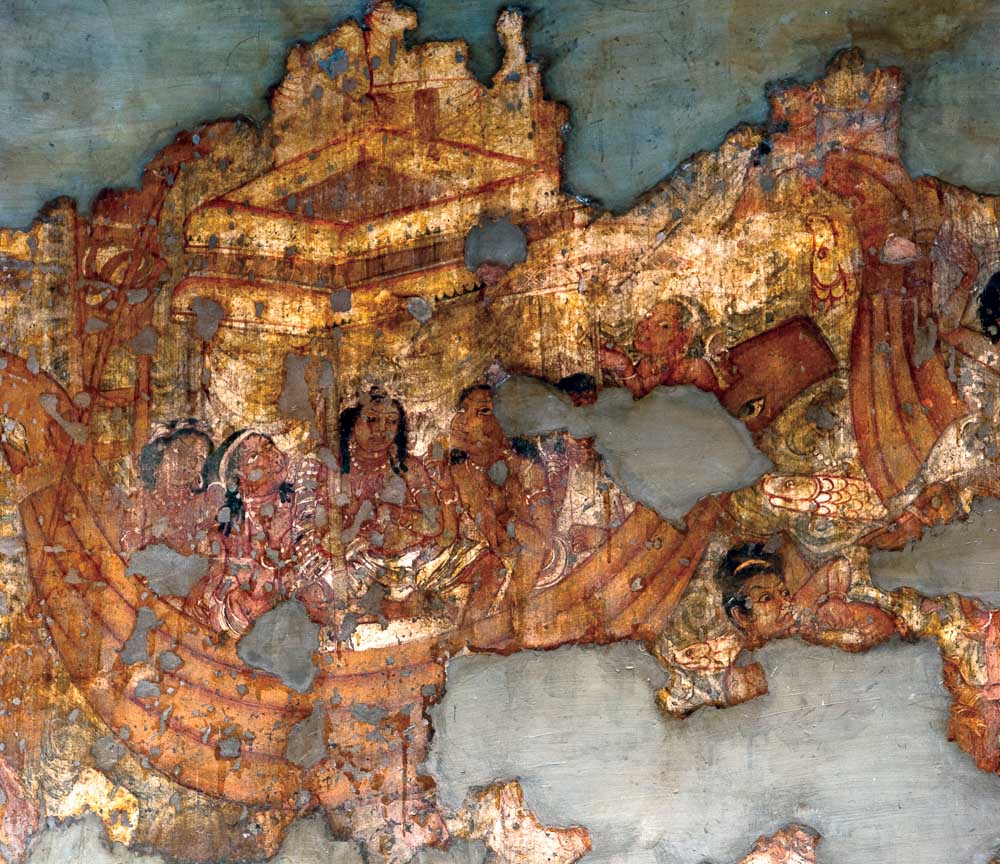Tag: Avadana
-

#38. Mahoṣadha
Ajanta cave 1 The narrative was identified by Goloubew (1927, 16). A prince was banished from his kingdom due to a court intrigue. He managed to reach Videha, his uncle’s kingdom. Shortly, the uncle died. So, the prince was crowned as the king of Videha. He found that there were six very corrupt ministers. So,…
-

#41. Kalyāṇakārin
Ajanta Cave 1 The narrative was identified by Schlingloff (1976, 5–16). Two princes, Kalyāṇakārin (‘Doing Good’) and Pāpakārin (‘Doing Evil’), bore the characteristics of their names. Once, Kalyāṇakārin, accompanied by Pāpakārin, embarked on a sea voyage in search of wealth as endless charity had emptied out the royal coffers. During their voyage, Kalyāṇakārin found a…
-

#45. Janaka
The narrative was identifiied by Goloubew (1927, 16). King Janaka of Videha believed that a person’s willpower was responsible for his successes. Once he was rescued from a shipwreck by a deity after he managed to keep afloat for a while on the sheer strength of his will. His will power also helped him secure…
-

#59. Śaṅkhapāla
Ajanta Cave 1 The narrative was identified by Foucher (1921, narrative no. 13). A nāga (serpent) king named Śaṅkhapāla visited a hermit to find out the reason behind his rejection of the worldly life. The hermit instructs the nāga king that he must practice asceticism to be reborn as a human. Thereafter when Śaṅkhapāla was…
-

#40. Sudhana
The narrative was identified by Dieter Schlingloff (1973a, 155–167). Summary of the story There was a nāga (one of a race of semi-human serpents) prince who ruled over a kingdom abutting his father, the nāga king’s, kingdom. Once a snake charmer sent by a human king to capture the nāga prince was killed by a…
-

#75. Udrāyaṇa
Ajanta Cave 1 The narrative was identified by Dieter Schlingloff (1987, 60). The legend is from the life of the Buddha.—King Udrāyaṇa of Roruka received a painting, representing the Buddha, as a gift from his friend, Bimbisāra, the king of Rājagṛha. Udrāyaṇa was so impressed by this painting that he summoned a monk to preach…
-

#46. Śibi-Kapota
Ajanta Cave 1 The narrative was identified by Alfred Foucher (1921, narrative no. 15). When Lord Indra complained about the imperfections of human beings, his architect Viśvakarmān drew his attention to King Śibi who was an archetype of justice and compassion. To test Śibi, Indra asked Viśvakarmān to assume a pigeon’s (kapota) appearance, while he…
-

#44. Mahāsudarśana
Ajanta Cave 1 The subject was identified by Dieter Schlingloff (1987, 59f.). A great king, Mahāsudarśana, ruled over the ancient and prosperous city of Kuśāvatī (Kuśinagara). The king was known for his sense of justice and was loved by the people. Once, some citizens went to him and offered him gold, jewels, and other precious…
-
#50. Maitrībala
The subject was identified by Dieter Schlingloff (1977b, 913). There lived a king by the name of Maitrībala (‘The Power of Benevolence’). He was extremely benevolent towards his subjects. Five demons, disguised as brahmans, entered his kingdom. They saw a lonely cowherd and asked him why he was not afraid of living on his own.…
